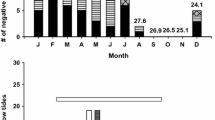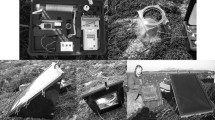Abstract
The seasonal photosynthetic responses and daily carbon gain of upper intertidal, low intertidal and subtidal (3 to 4 m depth) populations ofColpomenia peregrina were examined over a 2 yr period (1986–1988) in Santa Catalina Island, California, USA. The populations showed significant differences in their photosynthetic responses, daily carbon balance and carbon-specific growth rates when normalized to tissue area or to chlorophyll content. The substantial plasticity with respect to photosynthetic responses shown byC. peregrina is considered to be an important factor in facilitating the colonization of both intertidal and subtidal habitats. This species appears to have a cellular carbon metabolism influenced by responses to season and tidal elevation. Highest net daily carbon balance, predicted carbonspecific growth rates and net growth efficiency were achieved in upper intertidal habitats during summer. These parameters decreased in winter and progressively declined with increasing depth as plants become increasingly exposed to low-light regimes. The diminishing net daily carbon balance and predicted carbon-specific field growth rates found during winter suggest that standing stock and lower subtidal limits of distribution ofC. peregrina are at least partly controlled by these two factors.
Similar content being viewed by others
Literature cited
Alberte, R. S., Cheng, L., Lewin, R. A. (1986). Photosynthetic characteristics ofProchloron sp./ascidian symbioses. I. Light and temperature responses of the algal symbiont ofLissoclinum patella. Mar. Biol. 90: 575–587
Arnold, K. E., Littler, M. M. (1985). The carbon-14 method for measuring primary productivity. In: Littler, M. M., Littler, D. S. (eds.) Handbook of phycological methods, ecological field methods: macroalgae. Cambridge University Press, Cambridge
Axelsson, L. (1988). Changes in pH as a measure of photosynthesis by marine macroalgae. Mar. Biol. 97: 287–294
Buesa, R. J. (1980). Photosynthetic quotient of marine plants. Photosynthetica 14: 337–342
Dennison, W. C., Alberte, R. S. (1982). Photosynthetic responses ofZostera marina L. (eelgrass) toin situ manipulations of light intensity. Oecologia 55: 137–144
Dennison, W. C., Alberte, R. S. (1985). Role of daily light period in the depth distribution ofZostera marina (eelgrass). Mar. Ecol. Prog. Ser. 25: 51–61
Dring, M. T. (1982). The biology of marine plants. Edward Arnold Press, London
Emerson, S. E., Zedler, J. B. (1978). Recolonization of intertidal algae: an experimental study. Mar. Biol. 44: 315–324
Falkowski, P. G. (1981). Light-shade adaptation and assimilation numbers. J. Plankton Res. 3: 203–216
Falkowski, P. G., Dubinsky, Z., Wyman, K. (1985). Growth-irradiance relationships in phytoplankton. Limnol. Oceanogr. 30: 311–321
Foster, M. S. (1975). Algal succession in aMacrocystis pyrifera forest. Mar. Biol. 32: 313–329
Grasshoff, K., Ehrhardt, M., Kremling, K. (eds.) (1983). Methods of seawater analysis. Springer-Verlag, New York
Griffiths, D. J., Thinh, L., Florian, Z. (1978). A modified chamber for use with an oxygen electrode to allow measurement of incident illumination within the reaction suspension. Limnol. Oceanogr. 23: 368–372
Hatcher, B. G., Chapman, A. R. O., Mann, K. H. (1977) An annual carbon budget for the kelpLaminaria longicruris. Mar. Biol. 44: 85–96
Hoffman, W. E., Dawes, C. J. (1980). Photosynthetic rates and primary productivity by two Florida benthic red algal species from a salt marsh and a mangrove community. Bull. mar. Sci. 30: 358–364
Jassby, A. D., Platt, T. (1976), Mathematical formulation of the relationship between photosynthesis and light for phytoplankton. Limnol. Oceanogr. 21: 540–546
Jeffrey, S. W., Humphrey, G. F. (1975). New spectrophotometric equations for determining chlorophyllsa, b, c 1,c 2 in higher plants, algae and natural phytoplankton. Biochem. Physiol. Pfl. 167: 191–194
Littler, M. M., Arnold, K. E. (1980). Sources of variability in macroalgal primary productivity: sampling and interpretative problems. Aquat. Bot. 8: 141–156
Littler, M. M., Arnold, K. E. (1985). Electrodes and chemicals. In: Littler, M. M., Littler, D. S. (eds.) Handbook of phycological methods, ecological field methods: macroalgae. Cambridge University Press, Cambridge
Littler, M. M., Littler, D. S. (1980). The evolution of thallus form and survival strategies in benthic marine macroalgae: field and laboratory tests of a functional form model. Am. Nat. 116: 25–44
Littler, M. M., Murray, S. N., Arnold, K. E. (1979). Seasonal variations in net photosynthetic performance and cover of intertidal macrophytes. Aquat. Bot. 7: 35–46
Lobban, C. S., Harrison, P. J., Duncan, M. J. (1985). The physiological ecology of seaweeds. Cambridge University Press, Cambridge
Lüning, K. (1981). Light. In: Lobban, C. S., Wynne, M. J. (eds.). The biology of seaweeds. Blackwell Scientific Publications, Oxford
Marquardt, D. W. (1963). An algorithm for least-squares estimation of nonlinear parameters. J. Soc. ind. appl. Math. 11: 431–441
Matta, J. L. (1988). The seasonal photophysiology ofColpomenia peregrina (Phaeophyta) across a vertical distributional gradient in Santa Catalina Island, California. Ph.D. dissertation, Department of Biology, University of California, Los Angeles
Matta, J. L., Chapman, D. J. (1991). Morphological variability of the intertidal macroalgaColpomenia peregrina in relation to its net emersed carbon gain: interactions between light, temperature and desiccation (in preparation)
Murray, S. N., Littler, M. M. (1978). Patterns of algal succession in a perturbated marine intertidal community. J. Phycol. 14: 506–512
Oates, B. R. (1985a). Ecological, physiological and fine structural investigations of the functional morphology of intertidal saccate algae. Ph.D. dissertation. Department of Biology, University of California, Irvine
Oates, B. R. (1985b). Photosynthesis and amelioration of desiccation in the intertidal saccate algaColpomenia peregrina. Mar. Biol. 89: 1109–119
Peterson, B. J. (1980). Aquatic primary productivity and the14C-CO2 method: a history of the productivity problem. A. Rev. Ecol. Syst. 11: 359–385
Prézelin, B. B. (1981). Light reactions in photosynthesis. In: Platt, T. (ed.). Physiological bases of phytoplankton ecology. Can. Bull. Fish. aquat. Sciences 210: 1–43
Ramus, J. (1981). The capture and transduction of light energy. In: Lobban, C. S., Wynne, M. J. (eds.) The biology of seaweeds. Blackwell Scientific Publications, Oxford
Ramus, J., Lemons, F., Zimmerman, C. (1977). Adaptation of lightharvesting pigments to downwelling light and the consequent photosynthetic performance of the eulittoral rockweedsAscophyllum nodosum andFucus vesiculosus. Mar. Biol. 42: 293–303
Ramus, J., Rosenberg, G. (1980). Diurnal photosynthetic performance of seaweeds measured under natural conditions. Mar. Biol. 56: 21–28
Richardson, K., Beardall, J., Raven, J. A. (1983). Adaptation of unicellular algae to irradiance: an analysis of strategies. New Phytol. 93: 157–191
Seely, G. R., Duncan, M. J., Vidaver, W. E. (1972). Preparative and analytical extraction of pigments from brown algae with dimethyl sulfoxide. Mar. Biol. 12: 184–188
Smith, C. M. (1983). Photosynthetic tolerances to intertidal temperature and osmotic stress by select intertidal marine algae. Ph.D. dissertation. Department of Biology, Stanford University
Sokal, R. R., Rohlf, F. J. (1981). Biometry. The principles and practice of statistics in biological research. 2nd ed. W. H. Freeman & Co., San Francisco
Theis, C. L. (1985). Photosynthetic compensation relative to depth in three species of the green algaCodium from Santa Catalina Islands. M.S. thesis. Department of Biology, California State University, Fullerton
Vandermeulen, H. (1986). Growth ofColpomenia peregrina (Phaeophyceae) in culture: effects of salinity, temperature and daylength. J. Phycol. 22: 138–144
Vandermeulen, H., DeWreede, R. E. (1986). The phenology, mortality, dispersal and canopy species interaction ofColpomenia peregrina (Sauv.) Hamel in British Columbia. J. exp. mar. Biol. Ecol. 99: 31–47
Author information
Authors and Affiliations
Additional information
Communicated by M. G. Hadfield, Honolulu
Rights and permissions
About this article
Cite this article
Matta, J.L., Chapman, D.J. Photosynthetic responses and daily carbon balance ofColpomenia peregrina: Seasonal variations and differences between intertidal and subtidal populations. Mar. Biol. 108, 303–313 (1991). https://doi.org/10.1007/BF01344345
Accepted:
Issue Date:
DOI: https://doi.org/10.1007/BF01344345




